Satellite Remote Sensing for Monitoring Cork Oak Woodlands—A Comprehensive Literature Review
Abstract
1. Introduction
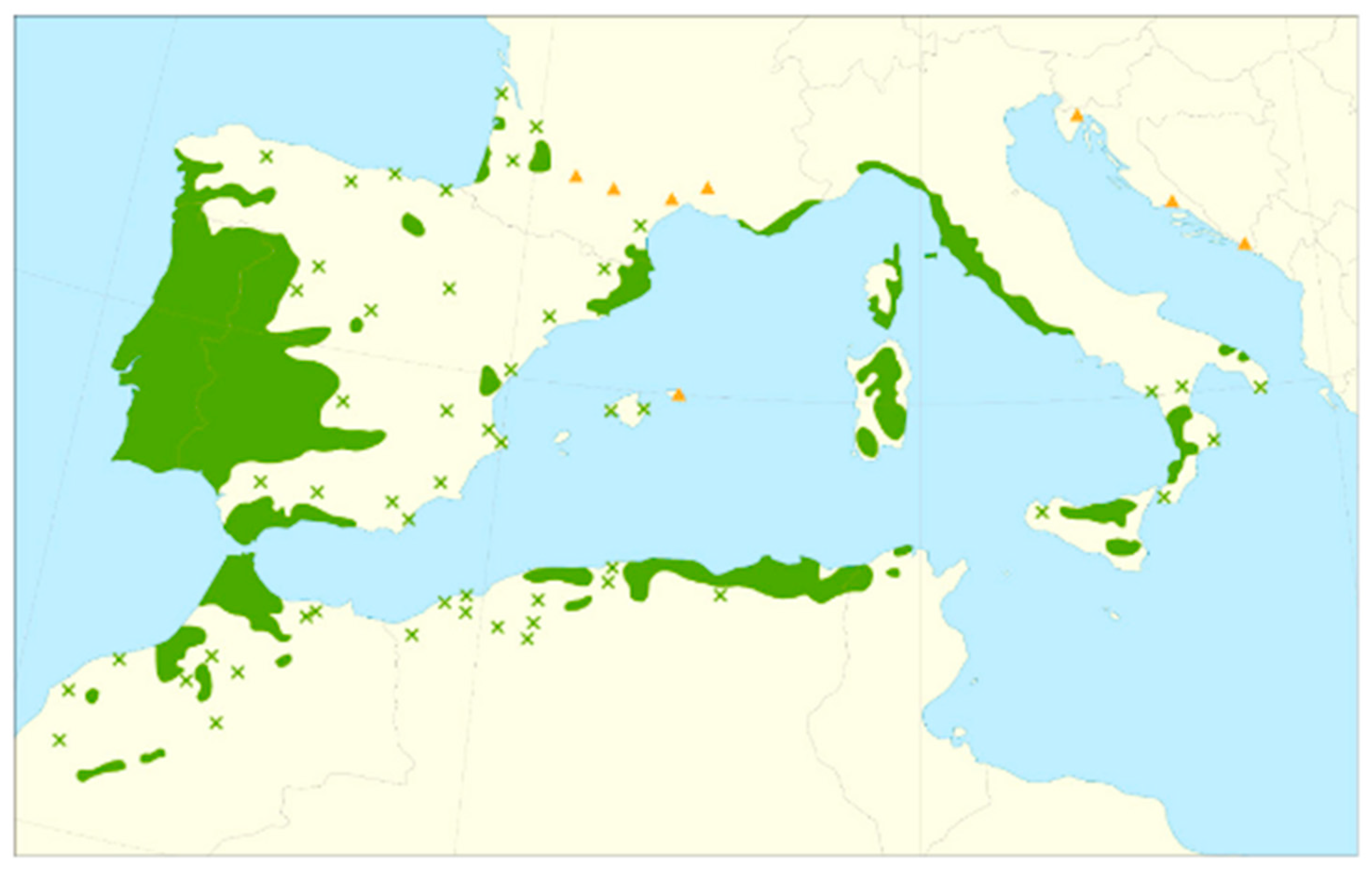
2. Materials and Methods
3. Results
3.1. Study Areas Distribution
3.2. Bibliometric Analysis
| Ref. | AOI | Satellite Data | Resolution [m] | Observation Period | Satellite-Derived Predictors | Object of the Study | Topic | Main Method/ Algorithm | Accuracies |
|---|---|---|---|---|---|---|---|---|---|
| [59] | ES | LS | 30 | 1994–2021 | NDVI | Aridity-induced phenological changes | EV | R2 = 0.57 | |
| [32] | ES | MODIS | 250 | 2000–2022 | Tree dover decline | FD | RTA (TS, CMK, FDR) | OA = 70.4% | |
| [35] | IT | S2, PS, S1 | 3 ÷ 10 | 2018–2022 | NDVI, GNDVI, MCARI, NDI45, NDWI, REIP, SCI, VH/VV, VHxVV, mRFDI | Epidemic outbreaks | FD | RF | OA = 74.4% OA = 50.88% |
| [43] | PT | S2 | 10 | 2019 | GNDVI, SAVI, NDII, EVI, NDRE 1, NDRE 2, CI | Land cover change | C | RF KNN | OA = 92.16% OA = 88.69% |
| [51] | MA | LS | 30 | 1985–2020 | NDVI, ARVI, CIgreen, DVI, EVI, GNDVI, OSAVI, SAVI, TVI | Biomass, Carbon stock | FV | MLR-biomass MLR-carbon stock | R2 = 0.81 R2 = 0.69 |
| [44] | MA | LS | 30 | 1989–2022 | RGB 3, 2, 1 RGB 4, 3, 2 | Land cover change | C | MLC | OA = 91.29% |
| [31] | MA | LS | 15 ÷ 60 | 2015–2017 | NDVI, SAVI | Forest dieback | FD | MLR, Kruskal-Wallis ANOVA, MCA | |
| [40] | MA | LS | 30 | 2000–2020 | GFC | Deforestation hotspots | FD | Getis-Ord Gi MK | |
| [36] | MA | MODIS | 250 | 2002–2020 | Fire_CC51, FIRMS | Wildfire risk assessment | FD | OHA EHA | |
| [52] | ES | LS | 30 | 1994–2008 | NDVI | Biomass, Productivity | FV | GLMM-biomass GLMM-productiv. | RMSE = 31.42 Mgha RMSE = 0.73 Mg/ha |
| [37] | ES | LS, S2, ASTER | 10 ÷ 100 | 2017–2021 | NDVI, LST | Wildfire risk assessment | FD | ||
| [60] | MA | LS | 2018 | NDVI | VIs for SOM modelling | EV | Pearson correlation matrix, ANOVA, Newman-Keuls post-hoc test | ||
| [33] | PT | Pleiades | 0.5 | 2018–2020 | NDVI, RGI, GNDVI | Dead tree detection | FD | K-means | OA = 98% |
| [50] | IT | LS | 30 | 2000–2020 | NDVI, EVI, SAVI, EVI2, MSAVI, NBR, NDWI | Species distribution | C | RF, GBT, GLM, KNN, CART | |
| [47] | MA | MODIS | 250 | 2000–2021 | NDVI, EVI | Land cover change | C | Pettitt homogeneity, MK | |
| [62] | ES | S2 | 10 | NDVI | Hydrology, terrain and vegetation | EV | |||
| [45] | DZ | LS | 30 | 1987–2017 | Land cover change | C | KNN | ||
| [63] | PT | LS, MODIS | 30 ÷ 1000 | 2013–2015 | Evapotranspiration (ET) | EV | STARFM | RMSE = 0.67 mm/day | |
| [41] | PT | MODIS | 1000 ÷ 10,000 | 2001–2018 | NDVI, LSA, LST | Water stress | FD | SEBS | R2 = 0.76 |
| [38] | ES | LS | 60 | 1975–1993 | NDVI | Postfire vegetation recovery | FD | ||
| [42] | ES | S2 | NDVI, SAVI | Water stress | FD | VI-ETo | RMSE = 0.47 mm/day | ||
| [55] | PT | LS | 15 ÷ 30 | 1984, 1999, 2014 | EVI, SWIR32, CRI1, CIG, NMDI, SATVI | Land cover change | C | SGB | OA = 81.85% OA = 75.58% OA = 80.07% |
| [34] | PT | S2 | 10 ÷ 60 m | 2017–2018 | NDVI, SAVI, NDWI, GNDVI, CIred, VCI | Diseased tree detection | FD | CDF | OA = 68% |
| [61] | PT | ASTER | 25 | NDWI | Groundwater Dependent Vegetation (GDV) | EV | GWR | ||
| [16] | PT | LS, MODIS | 30 ÷ 250 | 1984–2017 | NDVI | Biomass, Carbon stock, Productivity | FV | MK, CMK, TS | |
| [53] | PT | QB, WV2 | 0.5 ÷ 0.7 | 2006, 2011 | EVI, SAVI, NDVI, SR | Biomass, Carbon stock, Productivity | FV | CSS, OOC | |
| [46] | PT | LS | 30 | 1984–2009 | NDVI, TCT | Land cover change | C | CVA, SLCC | OA = 71% |
| [56] | PT | S2 | 10 | 2015 | NDVI, PSRI NDII, SWIR32, NDRE1-2-3 | Tree canopy cover | FV | SGB | |
| [58] | ES | LS, MODIS | 2012–2013 | LAI, LST | Water stress and ET | FV | TSEB | ||
| [54] | PT | LS | 2000–2013 | EVI | Biomass, Carbon stock, Productivity | FV | TSA, Kendall’s Tau, Spearman’s correlation | ||
| [57] | PT | LS | 30 ÷ 120 | AVI, BI, SI, SSI, TI, B1- B6 | Canopy density | FV | FCD | OA = 78% | |
| [64] | PT | LS, MODIS | 30 ÷ 120 | 2011 | EVI, SWIR32, CRI1, CIgreen, NMDI, SATVI | LST, LSA | EV | SGB | R2 = 0.86 R2 = 0.94 |
| [48] | IT | LS | 15 ÷ 30 | 2014–2015 | B1-B8 | Spectral signature | C | MLC-Scr study area MLC-Ang study area | OA = 93.3 OA = 87.7 |
| [49] | PT | MODIS | 500 | 2011–2013 | NDVI, SAVI, EVI | Spectral signature | C | GORT | |
| [39] | ES | QB | 2.4 | 2003–2004 | NDVI, B1, B2, B3, B4 | Postfire vegetation recovery | FD | RtA, BRT | R2 = 0.50 R2 = 0.65 R2 = 0.79 |
3.3. Satellite Missions and Derived Predictors
3.4. Statistical Performance
4. Discussion
4.1. Contextualization of the Study
4.2. Spatial Overview of Reviewed Research
4.3. Research Focus and Thematic Gaps
4.4. Satellite Data and Derived Predictors
4.5. Methods and Statistical Performance
4.6. From Monitoring to Management: Enhancing Ecosystem Resilience Through Sustainable Practices
4.7. Future Research Directions
5. Conclusions
Author Contributions
Funding
Conflicts of Interest
References
- Houston Durrant, T.; de Rigo, D.; Caudullo, G. Quercus Suber in Europe: Distribution, Habitat, Usage and Threats. In European Atlas of Forest Tree Species; Publication Office of the European Union: Luxembourg, 2016; pp. 1–8. [Google Scholar]
- Aronson, J.; Pereira, J.S.; Pausas, J.G. Cork Oak Woodlands on the Edge: Ecology, Adaptive Management, and Restoration; Island Press: Washington, DC, USA, 2009; ISBN 978-1-59726-478-5. [Google Scholar]
- Selvi, F.; Valleri, M. Cork Oak Woodlands in the North Tyrrhenian Area (Italy): Distribution and Plant Species Diversity of a Relict Forest Ecosystem. Biodivers. Conserv. 2012, 21, 3061–3078. [Google Scholar] [CrossRef]
- Dias, F.S.; Bugalho, M.N.; Orestes Cerdeira, J.; João Martins, M. Is Forest Certification Targeting Areas of High Biodiversity in Cork Oak Savannas? Biodivers. Conserv. 2013, 22, 93–112. [Google Scholar] [CrossRef]
- Pollastrini, M.; Chiavetta, U.; Cutini, A.; Casula, A.; Maltoni, S.; Dettori, S.; Corona, P. Indicators for the Assessment and Certification of Cork Oak Management Sustainability in Italy. iForest—Biogeosci. For. 2018, 11, 668–674. [Google Scholar] [CrossRef]
- European Commission. Council Regulation (EEC) No 1973/92 of 21 May 1992 Establishing a Financial Instrument for the Environment (LIFE). Off. J. Eur. Communities 1992, 35, 2–6. [Google Scholar]
- Camarero, J.J.; Gazol, A.; Valeriano, C.; Colangelo, M.; Rubio-Cuadrado, Á. Growth Responses to Climate and Drought in Relict Cork Oak Populations as a Benchmark of the Species Tolerance. Forests 2023, 15, 72. [Google Scholar] [CrossRef]
- Caudullo, G.; Welk, E.; San-Miguel-Ayanz, J. Chorological Maps for the Main European Woody Species. Data Br. 2017, 12, 662–666. [Google Scholar] [CrossRef]
- Bugalho, M.N.; Caldeira, M.C.; Pereira, J.S.; Aronson, J.; Pausas, J.G. Mediterranean Cork Oak Savannas Require Human Use to Sustain Biodiversity and Ecosystem Services. Front. Ecol. Environ. 2011, 9, 278–286. [Google Scholar] [CrossRef]
- APCOR Cortiça. Cork 2020; Associação Portuguesa da Cortiça: Aveiro, Portugal, 2020; pp. 1–108. [Google Scholar]
- Yadav, M.; Singhal, I. Sustainable Construction: The Use of Cork Material in the Building Industry. Mater. Renew. Sustain. Energy 2024, 13, 375–383. [Google Scholar] [CrossRef]
- Gibson, L.J. Cork: Structure, Properties, Applications. Available online: https://arboretum.harvard.edu/stories/cork-structure-properties-applications/ (accessed on 18 April 2025).
- Marques, M.; Bugalho, M.N.; Acácio, V.; Catry, F.X. Disentangling Research on Oak Decline Factors in Mediterranean-Type Climate Regions: A Systematic Review. Trees For. People 2025, 19, 100803. [Google Scholar] [CrossRef]
- FAO; Plan Bleu. State of Mediterranean Forests 2018; Food and Agriculture Organization of the United Nations (FAO): Rome, Italy; Plan Bleu: Marseille, France, 1310; ISBN 978-92-5-131047-2. [Google Scholar]
- Palma, J.H.N.; Paulo, J.A.; Faias, S.P.; Garcia-Gonzalo, J.; Borges, J.G.; Tomé, M. Adaptive Management and Debarking Schedule Optimization of Quercus Suber L. Stands under Climate Change: Case Study in Chamusca, Portugal. Reg. Environ. Change 2015, 15, 1569–1580. [Google Scholar] [CrossRef]
- Aubard, V.; Paulo, J.A.; Silva, J.M.N. Long-Term Monitoring of Cork and Holm Oak Stands Productivity in Portugal with Landsat Imagery. Remote Sens. 2019, 11, 525. [Google Scholar] [CrossRef]
- Stone, C.; Mohammed, C. Application of Remote Sensing Technologies for Assessing Planted Forests Damaged by Insect Pests and Fungal Pathogens: A Review. Curr. For. Rep. 2017, 3, 75–92. [Google Scholar] [CrossRef]
- Borghi, C.; Francini, S.; Pollastrini, M.; Bussotti, F.; Travaglini, D.; Marchetti, M.; Munafò, M.; Scarascia-Mugnozza, G.; Tonti, D.; Ottaviano, M.; et al. Monitoring Thirty-Five Years of Italian Forest Disturbance Using Landsat Time Series. Planet Care Space 2021, 2, 112–115. [Google Scholar]
- Forzieri, G.; Pecchi, M.; Girardello, M.; Mauri, A.; Klaus, M.; Nikolov, C.; Rüetschi, M.; Gardiner, B.; Tomastik, J.; Small, D.; et al. A Spatially Explicit Database of Wind Disturbances in European Forests over the Period 2000–2018. Earth Syst. Sci. Data 2020, 12, 257–276. [Google Scholar] [CrossRef]
- Gómez, C.; White, J.C.; Wulder, M.A. Optical Remotely Sensed Time Series Data for Land Cover Classification: A Review. ISPRS J. Photogramm. Remote Sens. 2016, 116, 55–72. [Google Scholar] [CrossRef]
- Hansen, M.C.; Potapov, P.V.; Moore, R.; Hancher, M.; Turubanova, S.A.; Tyukavina, A.; Thau, D.; Stehman, S.V.; Goetz, S.J.; Loveland, T.R.; et al. High-Resolution Global Maps of 21st-Century Forest Cover Change. Science 2013, 342, 850–853. [Google Scholar] [CrossRef]
- Müller, M.; Olsson, P.-O.; Eklundh, L.; Jamali, S.; Ardö, J. Response and Resilience to Drought in Northern Forests Revealed by Sentinel-2. Int. J. Remote Sens. 2024, 45, 5130–5157. [Google Scholar] [CrossRef]
- Francini, S.; Chirici, G. A Sentinel-2 Derived Dataset of Forest Disturbances Occurred in Italy between 2017 and 2020. Data Br. 2022, 42, 108297. [Google Scholar] [CrossRef]
- Giannetti, F.; Pecchi, M.; Travaglini, D.; Francini, S.; D’Amico, G.; Vangi, E.; Cocozza, C.; Chirici, G. Estimating VAIA Windstorm Damaged Forest Area in Italy Using Time Series Sentinel-2 Imagery and Continuous Change Detection Algorithms. Forests 2021, 12, 680. [Google Scholar] [CrossRef]
- Francini, S.; Chirici, G.; Chiesi, L.; Costa, P.; Caldarelli, G.; Mancuso, S. Global Spatial Assessment of Potential for New Peri-Urban Forests to Combat Climate Change. Nat. Cities 2024, 1, 286–294. [Google Scholar] [CrossRef]
- Gorelick, N.; Hancher, M.; Dixon, M.; Ilyushchenko, S.; Thau, D.; Moore, R. Google Earth Engine: Planetary-Scale Geospatial Analysis for Everyone. Remote Sens. Environ. 2017, 202, 18–27. [Google Scholar] [CrossRef]
- Bozzini, A.; Francini, S.; Chirici, G.; Battisti, A.; Faccoli, M. Spruce Bark Beetle Outbreak Prediction through Automatic Classification of Sentinel-2 Imagery. Forests 2023, 14, 1116. [Google Scholar] [CrossRef]
- Cavalli, A.; Francini, S.; McRoberts, R.E.; Falanga, V.; Congedo, L.; De Fioravante, P.; Maesano, M.; Munafò, M.; Chirici, G.; Scarascia Mugnozza, G. Estimating Afforestation Area Using Landsat Time Series and Photointerpreted Datasets. Remote Sens. 2023, 15, 923. [Google Scholar] [CrossRef]
- D’Amico, G.; Francini, S.; Giannetti, F.; Vangi, E.; Travaglini, D.; Chianucci, F.; Mattioli, W.; Grotti, M.; Puletti, N.; Corona, P.; et al. A Deep Learning Approach for Automatic Mapping of Poplar Plantations Using Sentinel-2 Imagery. GISci. Remote Sens. 2021, 58, 1352–1368. [Google Scholar] [CrossRef]
- Dallahi, Y.; Boujraf, A.; Meliho, M.; Orlando, C.A. Assessment of Forest Dieback on the Moroccan Central Plateau Using Spectral Vegetation Indices. J. For. Res. 2023, 34, 793–808. [Google Scholar] [CrossRef]
- Gutiérrez-Hernández, O.; García, L.V. Robust Trend Analysis in Environmental Remote Sensing: A Case Study of Cork Oak Forest Decline. Remote Sens. 2024, 16, 3886. [Google Scholar] [CrossRef]
- Catalão, J.; Navarro, A.; Calvão, J. Mapping Cork Oak Mortality Using Multitemporal High-Resolution Satellite Imagery. Remote Sens. 2022, 14, 2750. [Google Scholar] [CrossRef]
- Navarro, A.; Catalao, J.; Calvao, J. Assessing the Use of Sentinel-2 Time Series Data for Monitoring Cork Oak Decline in Portugal. Remote Sens. 2019, 11, 2515. [Google Scholar] [CrossRef]
- Sebastiani, A.; Bertozzi, M.; Vannini, A.; Morales-Rodriguez, C.; Calfapietra, C.; Vaglio Laurin, G. Monitoring Ink Disease Epidemics in Chestnut and Cork Oak Forests in Central Italy with Remote Sensing. Remote Sens. Appl. Soc. Environ. 2024, 36, 101329. [Google Scholar] [CrossRef]
- Boubekraoui, H.; Maouni, Y.; Ghallab, A.; Draoui, M.; Maouni, A. Wildfires Risk Assessment Using Hotspot Analysis and Results Application to Wildfires Strategic Response in the Region of Tangier-Tetouan-Al Hoceima, Morocco. Fire 2023, 6, 314. [Google Scholar] [CrossRef]
- Calvo, R.C.; Varo Martínez, M.Á.; Ruiz Gómez, F.; Ariza Salamanca, A.J.; Navarro-Cerrillo, R.M. Improvements of Fire Fuels Attributes Maps by Integrating Field Inventories, Low Density ALS, and Satellite Data in Complex Mediterranean Forests. Remote Sens. 2023, 15, 2023. [Google Scholar] [CrossRef]
- Prodon, R.; Diaz-Delgado, R. Assessing the Postfire Resilience of a Mediterranean Forest from Satellite and Ground Data (NDVI, Vegetation Profile, Avifauna). Écoscience 2021, 28, 81–91. [Google Scholar] [CrossRef]
- Viedma, O.; Torres, I.; Pérez, B.; Moreno, J.M. Modeling Plant Species Richness Using Reflectance and Texture Data Derived from QuickBird in a Recently Burned Area of Central Spain. Remote Sens. Environ. 2012, 119, 208–221. [Google Scholar] [CrossRef]
- Boubekraoui, H.; Maouni, Y.; Ghallab, A.; Draoui, M.; Maouni, A. Spatio-Temporal Analysis and Identification of Deforestation Hotspots in the Moroccan Western Rif. Trees For. People 2023, 12, 100388. [Google Scholar] [CrossRef]
- González-Dugo, M.P.; Chen, X.; Andreu, A.; Carpintero, E.; Gómez-Giraldez, P.J.; Carrara, A.; Su, Z. Long-Term Water Stress and Drought Assessment of Mediterranean Oak Savanna Vegetation Using Thermal Remote Sensing. Hydrol. Earth Syst. Sci. 2021, 25, 755–768. [Google Scholar] [CrossRef]
- Carpintero, E.; Andreu, A.; Gómez-Giráldez, P.J.; Blázquez, Á.; González-Dugo, M.P. Remote-Sensing-Based Water Balance for Monitoring of Evapotranspiration and Water Stress of a Mediterranean Oak–Grass Savanna. Water 2020, 12, 1418. [Google Scholar] [CrossRef]
- Isbaex, C.; Coelho, A.M.; Gonçalves, A.C.; Sousa, A.M.O. Mapping of Forest Species Using Sentinel-2A Images in the Alentejo and Algarve Regions, Portugal. Land 2024, 13, 2184. [Google Scholar] [CrossRef]
- Ghouldan, A.; Benhoussa, A.; Ichen, A. Evolution of Land Use/Land Cover in Mediterranean Forest Areas—A Case Study of the Maamora in the North-West Morocco. Ecol. Eng. Environ. Technol. 2024, 25, 134–149. [Google Scholar] [CrossRef]
- Bardadi, A.; Souidi, Z.; Cohen, M.; Amara, M. Land Use/Land Cover Changes in the Tlemcen Region (Algeria) and Classification of Fragile Areas. Sustainability 2021, 13, 7761. [Google Scholar] [CrossRef]
- Allen, H.; Simonson, W.; Parham, E.; de Basto e Santos, E.; Hotham, P. Satellite Remote Sensing of Land Cover Change in a Mixed Agro-Silvo-Pastoral Landscape in the Alentejo, Portugal. Int. J. Remote Sens. 2018, 39, 4663–4683. [Google Scholar] [CrossRef]
- Moukrim, S.; Benabou, A.; Lahssini, S.; Aafi, A.; Chkhichekh, A.; Moudden, F.; Ben Bammou, M.; El Aboudi, A.; Laaribya, S. Spatio-Temporal Analysis of North African Forest Cover Dynamics Using Time Series of Vegetation Indices—Case of the Maamora Forest (Morocco). Biosyst. Divers. 2022, 30, 372–379. [Google Scholar] [CrossRef]
- Modica, G.; Solano, F.; Merlino, A.; Di Fazio, S.; Barreca, F.; Laudari, L.; Fichera, C.R. Using Landsat 8 Imagery in Detecting Cork Oak (Quercus Suber L.) Woodlands: A Case Study in Calabria (Italy). J. Agric. Eng. 2016, 47, 205. [Google Scholar] [CrossRef]
- Häusler, M.; Silva, J.M.N.; Cerasoli, S.; López-Saldaña, G.; Pereira, J.M.C. Modelling Spectral Reflectance of Open Cork Oak Woodland: A Simulation Analysis of the Effects of Vegetation Structure and Background. Int. J. Remote Sens. 2016, 37, 492–515. [Google Scholar] [CrossRef]
- Bonannella, C.; Hengl, T.; Heisig, J.; Parente, L.; Wright, M.N.; Herold, M.; de Bruin, S. Forest Tree Species Distribution for Europe 2000–2020: Mapping Potential and Realized Distributions Using Spatiotemporal Machine Learning. PeerJ 2022, 10, e13728. [Google Scholar] [CrossRef]
- Fadil, S.; Sebari, I.; Ajerame, M.M.; Ajeddour, R.; El Maghraoui, I.; Ait El kadi, K.; Zefri, Y.; Jabrane, M. An Integrating Framework for Biomass and Carbon Stock Spatialization and Dynamics Assessment Using Unmanned Aerial Vehicle LiDAR (LiDAR UAV) Data, Landsat Imagery, and Forest Survey Data in the Mediterranean Cork Oak Forest of Maamora. Land 2024, 13, 688. [Google Scholar] [CrossRef]
- Herraiz, A.D.; Salazar-Zarzosa, P.C.; Mesas, F.J.; Arenas-Castro, S.; Ruiz-Benito, P.; Villar, R. Modelling Aboveground Biomass and Productivity and the Impact of Climate Change in Mediterranean Forests of South Spain. Agric. For. Meteorol. 2023, 337, 109498. [Google Scholar] [CrossRef]
- Gonçalves, A.C.; Sousa, A.M.O.; Mesquita, P. Functions for Aboveground Biomass Estimation Derived from Satellite Images Data in Mediterranean Agroforestry Systems. Agrofor. Syst. 2019, 93, 1485–1500. [Google Scholar] [CrossRef]
- Santos, M.; Baumann, M.; Esgalhado, C. Drivers of Productivity Trends in Cork Oak Woodlands over the Last 15 Years. Remote Sens. 2016, 8, 486. [Google Scholar] [CrossRef]
- Machado, R.; Godinho, S.; Guiomar, N.; Gil, A.; Pirnat, J. Using Graph Theory to Analyse and Assess Changes in Mediterranean Woodland Connectivity. Landsc. Ecol. 2020, 35, 1291–1308. [Google Scholar] [CrossRef]
- Godinho, S.; Guiomar, N.; Gil, A. Estimating Tree Canopy Cover Percentage in a Mediterranean Silvopastoral Systems Using Sentinel-2A Imagery and the Stochastic Gradient Boosting Algorithm. Int. J. Remote Sens. 2018, 39, 4640–4662. [Google Scholar] [CrossRef]
- Godinho, S.; Gil, A.; Guiomar, N.; Neves, N.; Pinto-Correia, T. A Remote Sensing-Based Approach to Estimating Montado Canopy Density Using the FCD Model: A Contribution to Identifying HNV Farmlands in Southern Portugal. Agrofor. Syst. 2016, 90, 23–34. [Google Scholar] [CrossRef][Green Version]
- Andreu, A.; Kustas, W.P.; Polo, M.J.; Carrara, A.; González-Dugo, M.P. Modeling Surface Energy Fluxes over a Dehesa (Oak Savanna) Ecosystem Using a Thermal Based Two Source Energy Balance Model (TSEB) II—Integration of Remote Sensing Medium and Low Spatial Resolution Satellite Images. Remote Sens. 2018, 10, 558. [Google Scholar] [CrossRef]
- Herraiz, A.D.; Salazar-Zarzosa, P.; Acosta-Muñoz, C.; Hernández-Clemente, R.; Villar, R. Aridity-Induced Phenological Shifts and Greening Trends in Mediterranean Forest Species: Insights from 28 Years of Landsat Data in Southern Spain. Ecol. Indic. 2025, 171, 113115. [Google Scholar] [CrossRef]
- Dallahi, Y.; Malaainine, M.E.I.; Hbiak, I.; Boujraf, A.; Ould Abidine, M.M.; Orlando, C.A.; Meliho, M.; El Mderssa, M.; Minoubi, A. Contribution to the Modeling of the Organic Matter of Moroccan Forest Soils within the Context of Global Change: Case Study of the Central Plateau. Ecol. Eng. Environ. Technol. 2023, 24, 261–271. [Google Scholar] [CrossRef]
- Gomes Marques, I.; Nascimento, J.; Cardoso, R.M.; Miguéns, F.; Condesso de Melo, M.T.; Soares, P.M.M.; Gouveia, C.M.; Kurz Besson, C. Mapping the Suitability of Groundwater-Dependent Vegetation in a Semi-Arid Mediterranean Area. Hydrol. Earth Syst. Sci. 2019, 23, 3525–3552. [Google Scholar] [CrossRef]
- García-Gamero, V.; Peña, A.; Laguna, A.M.; Giráldez, J.V.; Vanwalleghem, T. Factors Controlling the Asymmetry of Soil Moisture and Vegetation Dynamics in a Hilly Mediterranean Catchment. J. Hydrol. 2021, 598, 126207. [Google Scholar] [CrossRef]
- Carpintero, E.; Anderson, M.C.; Andreu, A.; Hain, C.; Gao, F.; Kustas, W.P.; González-Dugo, M.P. Estimating Evapotranspiration of Mediterranean Oak Savanna at Multiple Temporal and Spatial Resolutions. Implications for Water Resources Management. Remote Sens. 2021, 13, 3701. [Google Scholar] [CrossRef]
- Godinho, S.; Gil, A.; Guiomar, N.; Costa, M.J.; Neves, N. Assessing the Role of Mediterranean Evergreen Oaks Canopy Cover in Land Surface Albedo and Temperature Using a Remote Sensing-Based Approach. Appl. Geogr. 2016, 74, 84–94. [Google Scholar] [CrossRef]
- Sacchelli, S.; Borghi, C.; Fratini, R.; Bernetti, I. Assessment and Valorization of Non-Wood Forest Products in Europe: A Quantitative Literature Review. Sustainability 2021, 13, 3533. [Google Scholar] [CrossRef]
- Pinto-Correia, T.; Muñoz-Rojas, J.; Thorsøe, M.H.; Noe, E.B. Governance Discourses Reflecting Tensions in a Multifunctional Land Use System in Decay; Tradition Versus Modernity in the Portuguese Montado. Sustainability 2019, 11, 3363. [Google Scholar] [CrossRef]
- Sørensen, I.H.; Torralba, M.; Quintas-Soriano, C.; Muñoz-Rojas, J.; Plieninger, T. Linking Cork to Cork Oak Landscapes: Mapping the Value Chain of Cork Production in Portugal. Front. Sustain. Food Syst. 2021, 5, 787045. [Google Scholar] [CrossRef]
- White, J.C.; Wulder, M.A.; Hermosilla, T.; Coops, N.C.; Hobart, G.W. A Nationwide Annual Characterization of 25 Years of Forest Disturbance and Recovery for Canada Using Landsat Time Series. Remote Sens. Environ. 2017, 194, 303–321. [Google Scholar] [CrossRef]
- Warren, S.D.; Alt, M.; Olson, K.D.; Irl, S.D.H.; Steinbauer, M.J.; Jentsch, A. The Relationship between the Spectral Diversity of Satellite Imagery, Habitat Heterogeneity, and Plant Species Richness. Ecol. Inform. 2014, 24, 160–168. [Google Scholar] [CrossRef]
- Huang, S.; Tang, L.; Hupy, J.P.; Wang, Y.; Shao, G. A Commentary Review on the Use of Normalized Difference Vegetation Index (NDVI) in the Era of Popular Remote Sensing. J. For. Res. 2021, 32, 1–6. [Google Scholar] [CrossRef]
- Hornero, A.; Zarco-Tejada, P.J.; Marengo, I.; Faria, N.; Hernández-Clemente, R. Detection of Oak Decline Using Radiative Transfer Modelling and Machine Learning from Multispectral and Thermal RPAS Imagery. Int. J. Appl. Earth Obs. Geoinf. 2024, 127, 103679. [Google Scholar] [CrossRef]
- Soares, C.; Silva, J.M.N.; Boavida-Portugal, J.; Cerasoli, S. Spectral-Based Monitoring of Climate Effects on the Inter-Annual Variability of Different Plant Functional Types in Mediterranean Cork Oak Woodlands. Remote Sens. 2022, 14, 711. [Google Scholar] [CrossRef]
- Guerra, R.; Pires, R.; Brázio, A.; Cavaco, A.M.; Schütz, G.; Coelho, A.C. Spectral Analysis, Biocompounds, and Physiological Assessment of Cork Oak Leaves: Unveiling the Interaction with Phytophthora Cinnamomi and Beyond. Forests 2023, 14, 1663. [Google Scholar] [CrossRef]
- Cerasoli, S.; Costa e Silva, F.; Silva, J.M.N. Temporal Dynamics of Spectral Bioindicators Evidence Biological and Ecological Differences among Functional Types in a Cork Oak Open Woodland. Int. J. Biometeorol. 2016, 60, 813–825. [Google Scholar] [CrossRef]
- Gentilesca, T.; Camarero, J.; Colangelo, M.; Nolè, A.; Ripullone, F. Drought-Induced Oak Decline in the Western Mediterranean Region: An Overview on Current Evidences, Mechanisms and Management Options to Improve Forest Resilience. iForest—Biogeosci. For. 2017, 10, 796–806. [Google Scholar] [CrossRef]
- Pettorelli, N.; Laurance, W.F.; O’Brien, T.G.; Wegmann, M.; Nagendra, H.; Turner, W. Satellite Remote Sensing for Applied Ecologists: Opportunities and Challenges. J. Appl. Ecol. 2014, 51, 839–848. [Google Scholar] [CrossRef]
- Cohen-Shacham, E.; Walters, G.; Janzen, C.; Maginnis, S. (Eds.) Nature-Based Solutions to Address Global Societal Challenges; IUCN International Union for Conservation of Nature: Gland, Switzerland, 2016; ISBN 9782831718125. [Google Scholar]
- Shaik, R.U.; Laneve, G.; Fusilli, L. An Automatic Procedure for Forest Fire Fuel Mapping Using Hyperspectral (PRISMA) Imagery: A Semi-Supervised Classification Approach. Remote Sens. 2022, 14, 1264. [Google Scholar] [CrossRef]
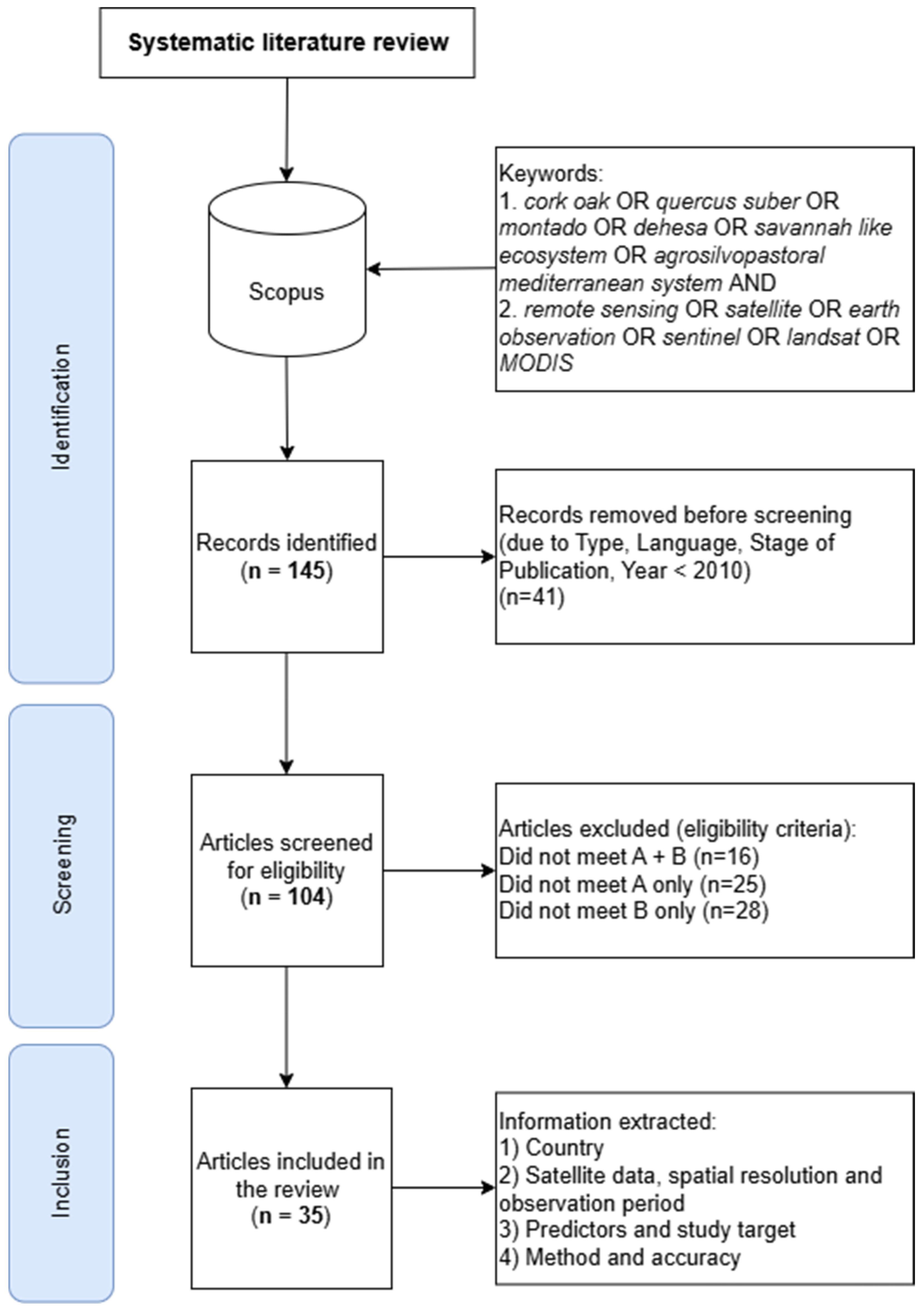
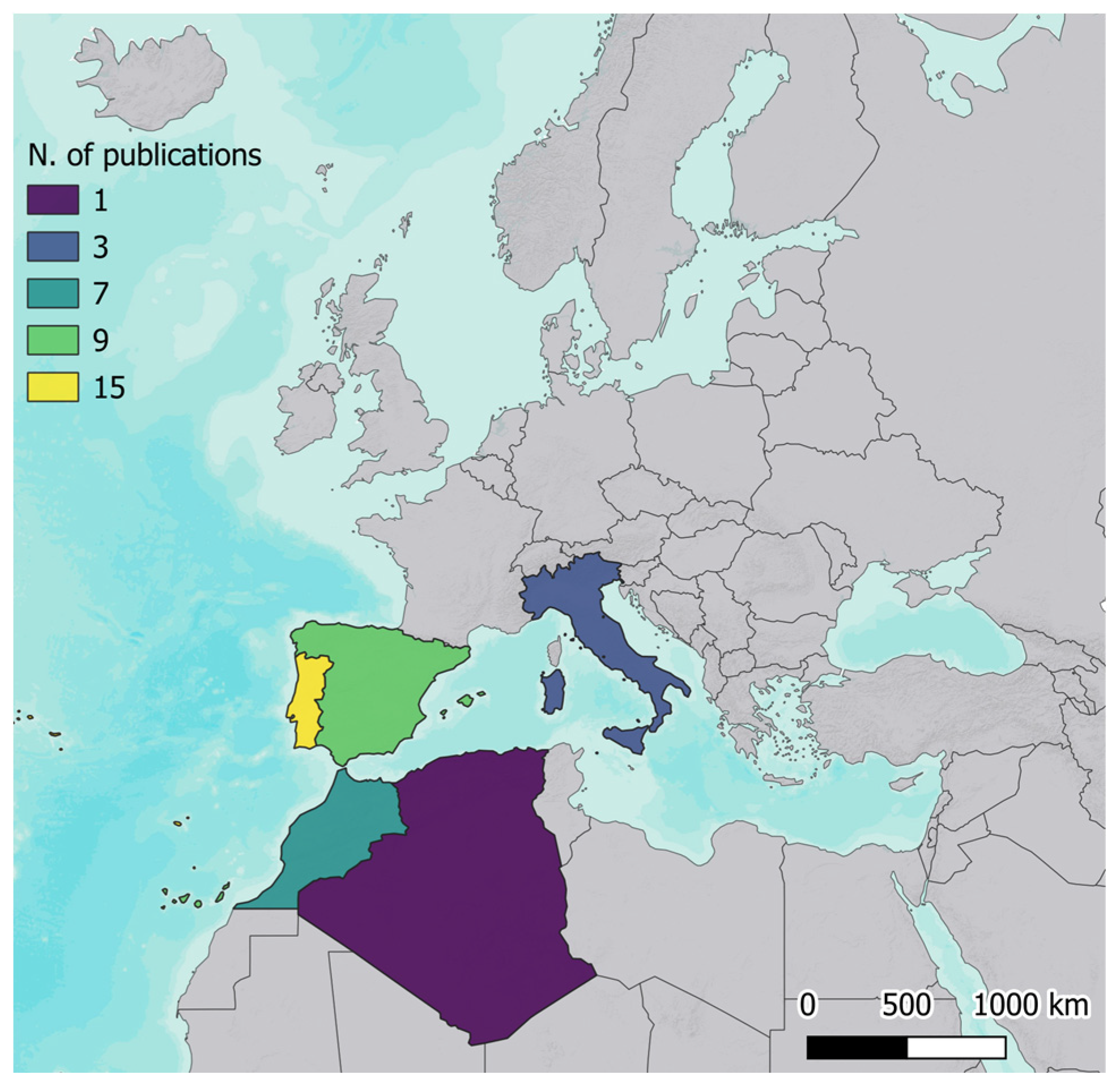


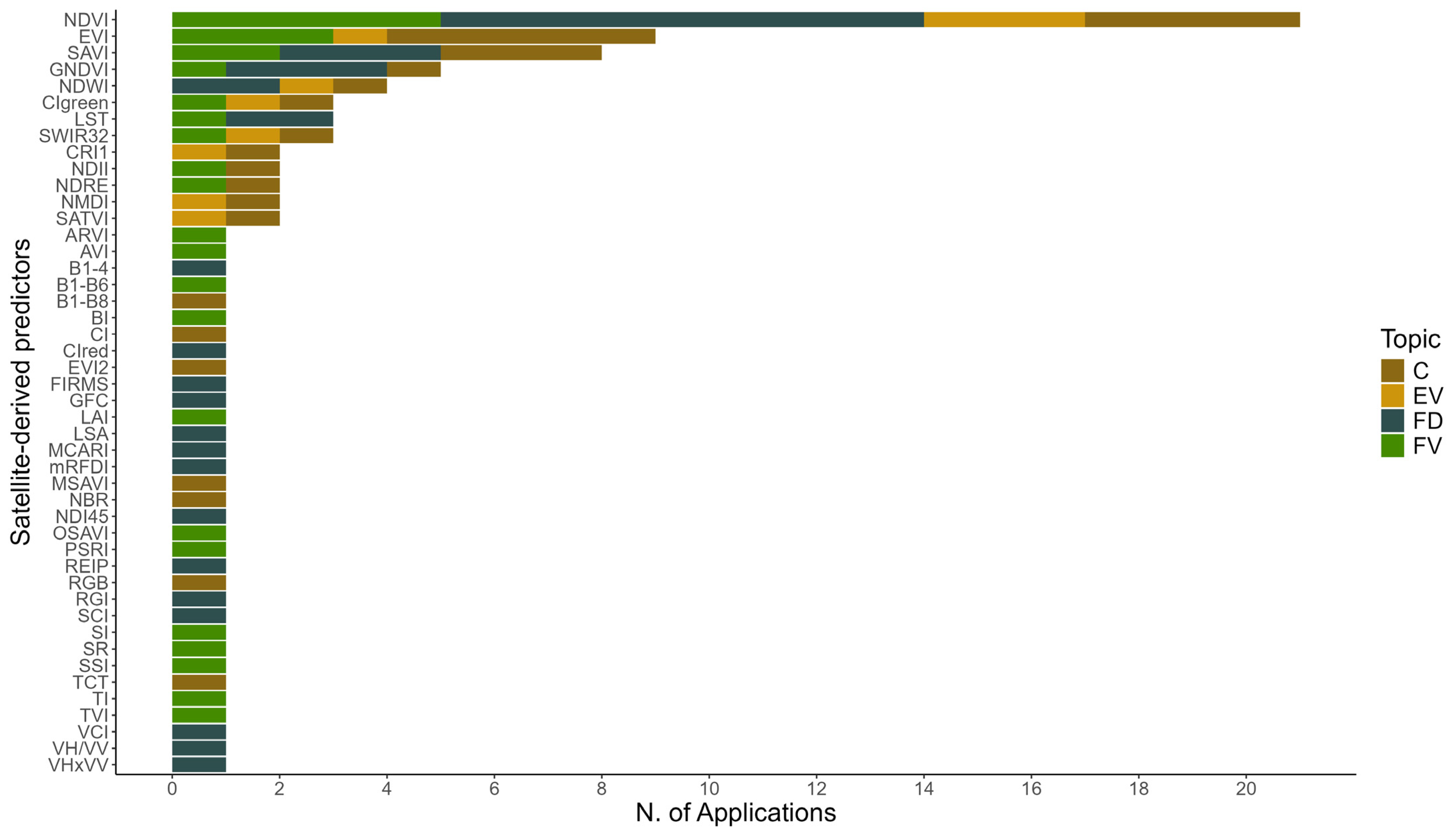
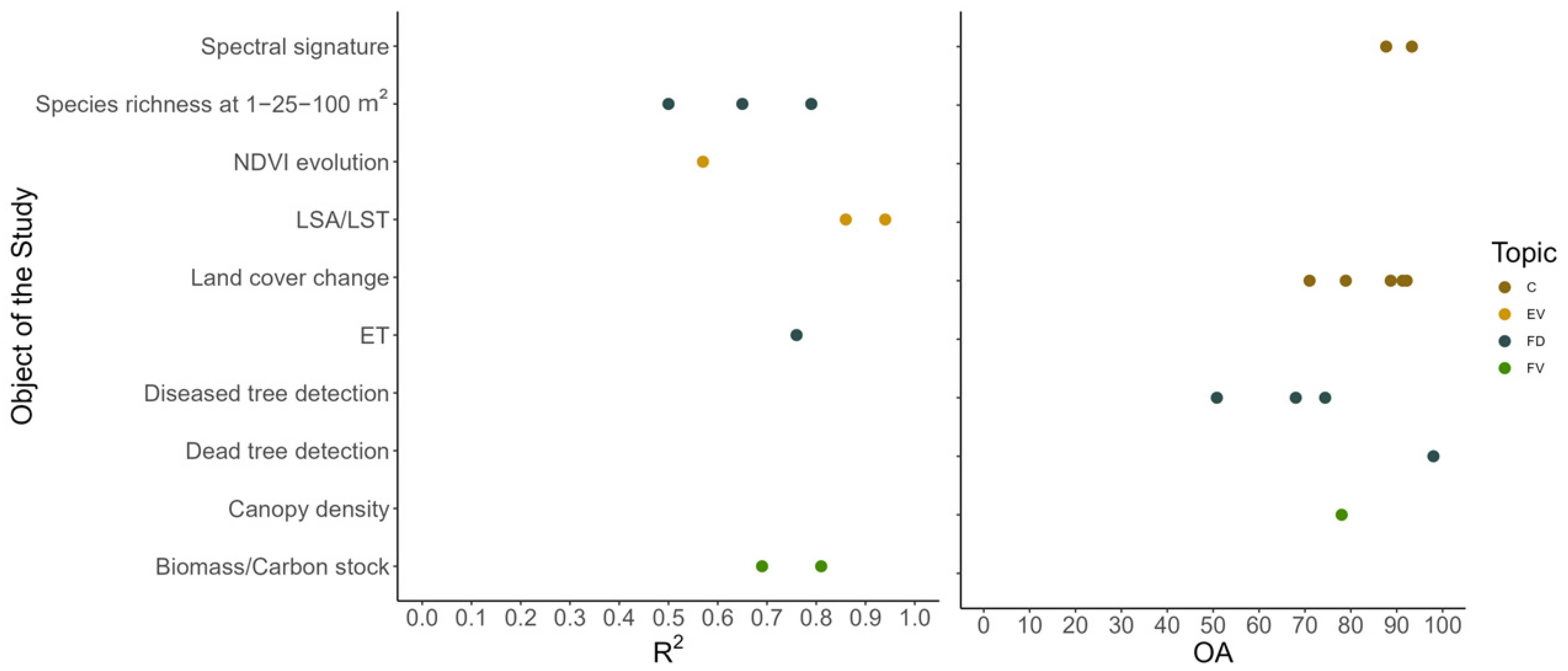
Disclaimer/Publisher’s Note: The statements, opinions and data contained in all publications are solely those of the individual author(s) and contributor(s) and not of MDPI and/or the editor(s). MDPI and/or the editor(s) disclaim responsibility for any injury to people or property resulting from any ideas, methods, instructions or products referred to in the content. |
© 2025 by the authors. Licensee MDPI, Basel, Switzerland. This article is an open access article distributed under the terms and conditions of the Creative Commons Attribution (CC BY) license (https://creativecommons.org/licenses/by/4.0/).
Share and Cite
Bambagioni, E.; Anzilotti, S.; Borghi, C.; Chirici, G.; Salbitano, F.; Marchetti, M.; Francini, S. Satellite Remote Sensing for Monitoring Cork Oak Woodlands—A Comprehensive Literature Review. Diversity 2025, 17, 420. https://doi.org/10.3390/d17060420
Bambagioni E, Anzilotti S, Borghi C, Chirici G, Salbitano F, Marchetti M, Francini S. Satellite Remote Sensing for Monitoring Cork Oak Woodlands—A Comprehensive Literature Review. Diversity. 2025; 17(6):420. https://doi.org/10.3390/d17060420
Chicago/Turabian StyleBambagioni, Emma, Solaria Anzilotti, Costanza Borghi, Gherardo Chirici, Fabio Salbitano, Marco Marchetti, and Saverio Francini. 2025. "Satellite Remote Sensing for Monitoring Cork Oak Woodlands—A Comprehensive Literature Review" Diversity 17, no. 6: 420. https://doi.org/10.3390/d17060420
APA StyleBambagioni, E., Anzilotti, S., Borghi, C., Chirici, G., Salbitano, F., Marchetti, M., & Francini, S. (2025). Satellite Remote Sensing for Monitoring Cork Oak Woodlands—A Comprehensive Literature Review. Diversity, 17(6), 420. https://doi.org/10.3390/d17060420







